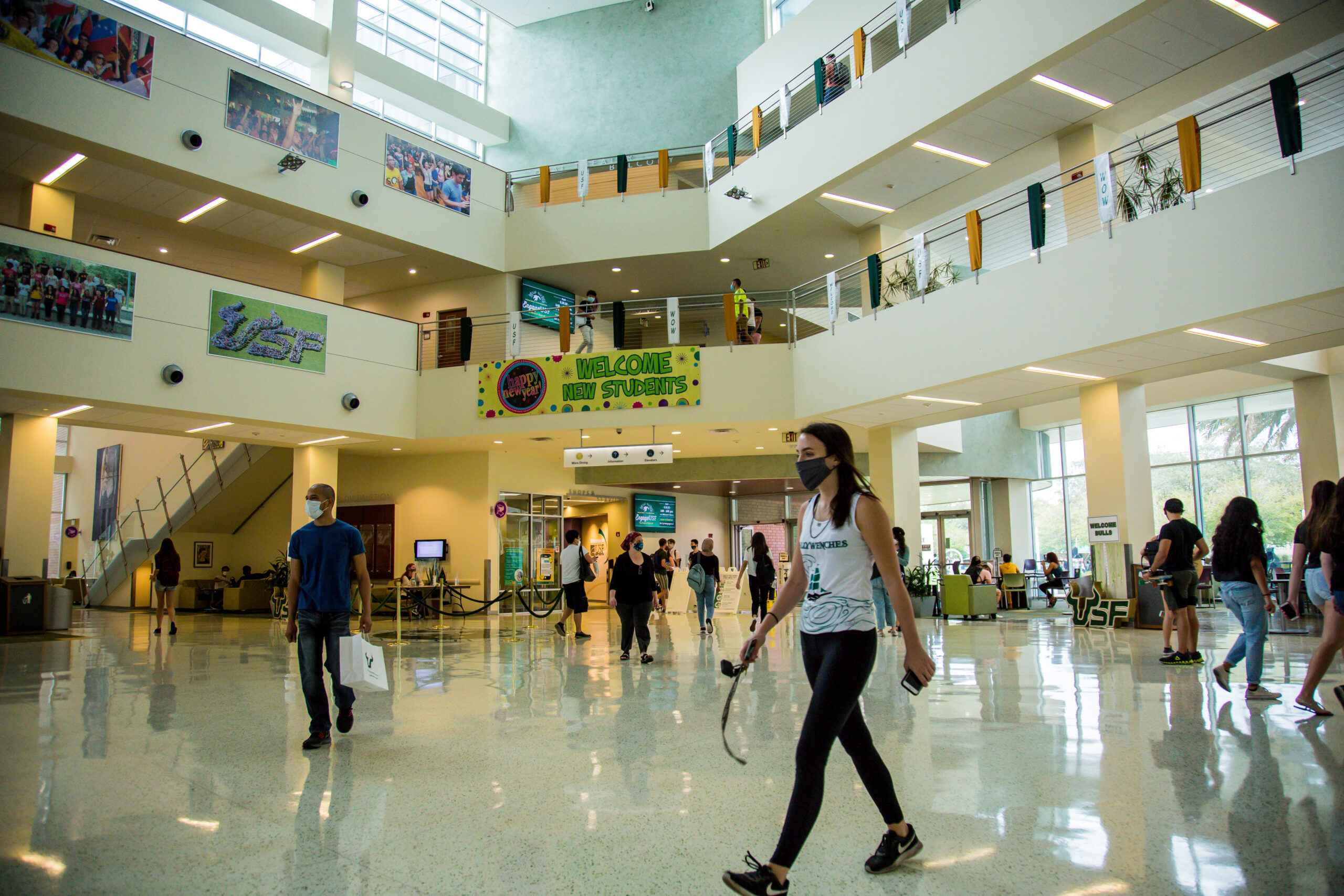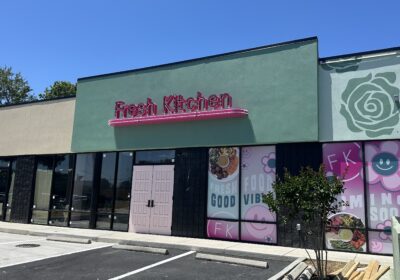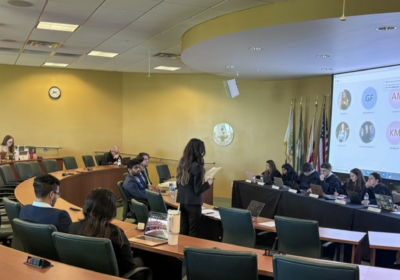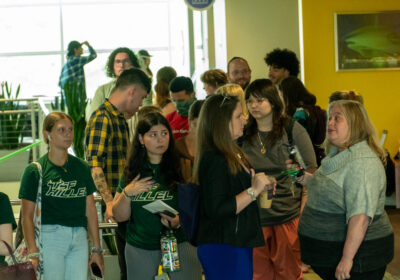Despite the odds, first day of fall enrollment only slightly affected

Since the pandemic began, many have been confronted with challenges — concerns over employment, finances and a shift into a remote world — but at USF, enrollment numbers on the first day of fall 2020 classes remained relatively the same as they were last year.
Provost Ralph Wilcox on Tuesday presented to the USF Board of Trustees (BOT) an update for the 2020 summer and fall semesters, and total enrollment was encouraging — 50,404 students across all three campuses, Tampa, St. Petersburg and Sarasota-Manatee, on the first day of fall classes.
“[First-day enrollment] is quite remarkably 99 percent of the planned enrollment that [the BOT] approved, way back as part of our 2020 Accountability Plan,” Wilcox said.
There are 288 fewer students enrolled at USF than there were last year at this time, according to Wilcox. This makes enrollment down less than 1 percent of the BOT’s planned enrollment for undergraduate and graduate students from the 2020 Accountability Plan.
“We’re off to a pretty good start,” said Wilcox. “With an overall 3.1 percent increase with enrollment for summer plus fall, year over year — and all of this in the midst of challenges that we’ve just never faced before.”
Despite enrollment being down less than 1 percent, student credit hours are up nearly 1 percent, according to Wilcox.
The 2020 freshman class, which includes incoming students for the summer and fall semesters, also is the highest-achieving freshman class in USF history with an average Scholastic Assessment Test (SAT) score of 1,312 and an average high school GPA of 4.18. For last year’s freshman class, the average was a 1,285 SAT score and 4.13 GPA.
“Of course, our performance on the Tampa campus of 1,312 and 4.18 exceeds our goal for this year and, by a long stretch, it eclipses the statewide benchmark of 1,200 and 4.0 set for preeminence,” said Wilcox. “In fact, all three campuses exceed that preeminence benchmark.”
The demographics of the 2020 enrollment numbers were also a part of Wilcox’s presentation, with enrollment for Black students having decreased compared to other minority groups on campus, which have increased, including those who identify as multiracial.
“Overall we have a lot of work to do to impress a declining proportion of Black students enrolled at the University of South Florida that’s down 4.3 percent from the total student population,” said Wilcox.
Recruitment of Black students was also discussed in the presentation of the 2018-2019 Equity Report by Associate Vice President of the Office of Diversity, Inclusion and Equal Opportunity (DIEO) Cecil Howard and Vice President of Institutional Equity Haywood Brown.
“It’s no question that we’re stuck in a sustainable level of both Black students and white students and that’s likely not to get any better without some intentional strategies,” said Brown. “So our goal is to be a little more intentional in our recruitment when it comes to Black students and brown students for that matter.”
The DIEO has been working on creating relationships with local high schools in the area as a part of its recruitment efforts to increase Black enrollment. However, these recruitment efforts can be competitive as USF has to prove itself among other universities in and out of state that are also recruiting in the Tampa Bay area, according to Brown.
“We need to be better known as a [university] if we are going to be able to get to those goals,” said Brown.
The DIEO has also been working with USF alumni in their recruitment efforts through the Black Leadership Network, “a partnership-based group focused on enhancing the educational and leadership opportunities of USF African American students and African American student initiatives through the support of scholarships and programmatic initiatives throughout USF and in our communities,” according to the USF Foundation website.
“This is what it’s going to take, it’s going to take our students and alumni to help us to get out there to do a better job with fewer resources, as we engage,” said Brown. “I will tell you that we’re engaging, you know, at the ninth- and 10th-grade level. We’re going to have to start engaging at sixth- and seventh- and eighth-grade level.
“We have to get there a little earlier and have South Florida be a partner with these school systems.”
Brown is also recommending more resources for recruitment to reconcile disparities in representation at the faculty level.
“They’re not the worst numbers around, let me just say that, but we do believe this is room for opportunity,” said Howard, regarding the demographic numbers for USF faculty.
Other plans are also in the works by the DIEO to develop a more diverse faculty at USF. As of right now, 65.38 percent of faculty are white.
“As far as faculty is concerned, we’re already engaged in various programs that Dr. Wilcox can tell you about,” Brown said. “As far as graduate students are concerned, bringing in a more diverse group of graduate students, and creating a pipeline program so those graduate students become faculty, and those faculty become leaders.”
“These are absolutely active conversations.”
While there are plans to make up for where USF is lacking in reaching its diversity objectives, there may be some achievements for the university coming soon in other ways.
“We are organically … moving toward becoming a Hispanic-serving institution,” said Howard. “We will reach that once we reach a number of 25 percent full-time [Hispanic] undergraduate students.”
The Hispanic student population at USF has been growing since 2013 and made up 21 percent of the undergraduate student population in 2019.
USF also has the greatest population of Hispanic and Asian students compared to UF and FSU — Florida’s other preeminent universities. It has the second-highest percentage of Black students behind FSU.
But Howard made sure not to let the presentation of the information serve as a moment of complacency.
“My caution to us is that we not rest on our laurels because we are outperforming our peers, but instead see how effective we can be at intentionally moving forward to increasing where we are,” said Howard.
It was even suggested that USF change the way it measures its success, and broaden its comparisons in diversity to universities across the nation.
“We know that we’re for the most part doing better than the other two preeminent universities, but we need to benchmark against the 36 public AAU institutions, and the 93 Research 1 public institutions across the nation,” said Wilcox.
Despite the enrollment numbers only reflecting the first day of the fall semester, Wilcox remains hopeful that if the numbers were to change, it would be in a positive direction.
“We do expect this enrollment to change. Generally, for the better, but who knows this year, generally to the better and by the end of this week,” Wilcox said.
The university will have new enrollment numbers Friday once the window closes for students to either add or drop classes to their courses schedules.






